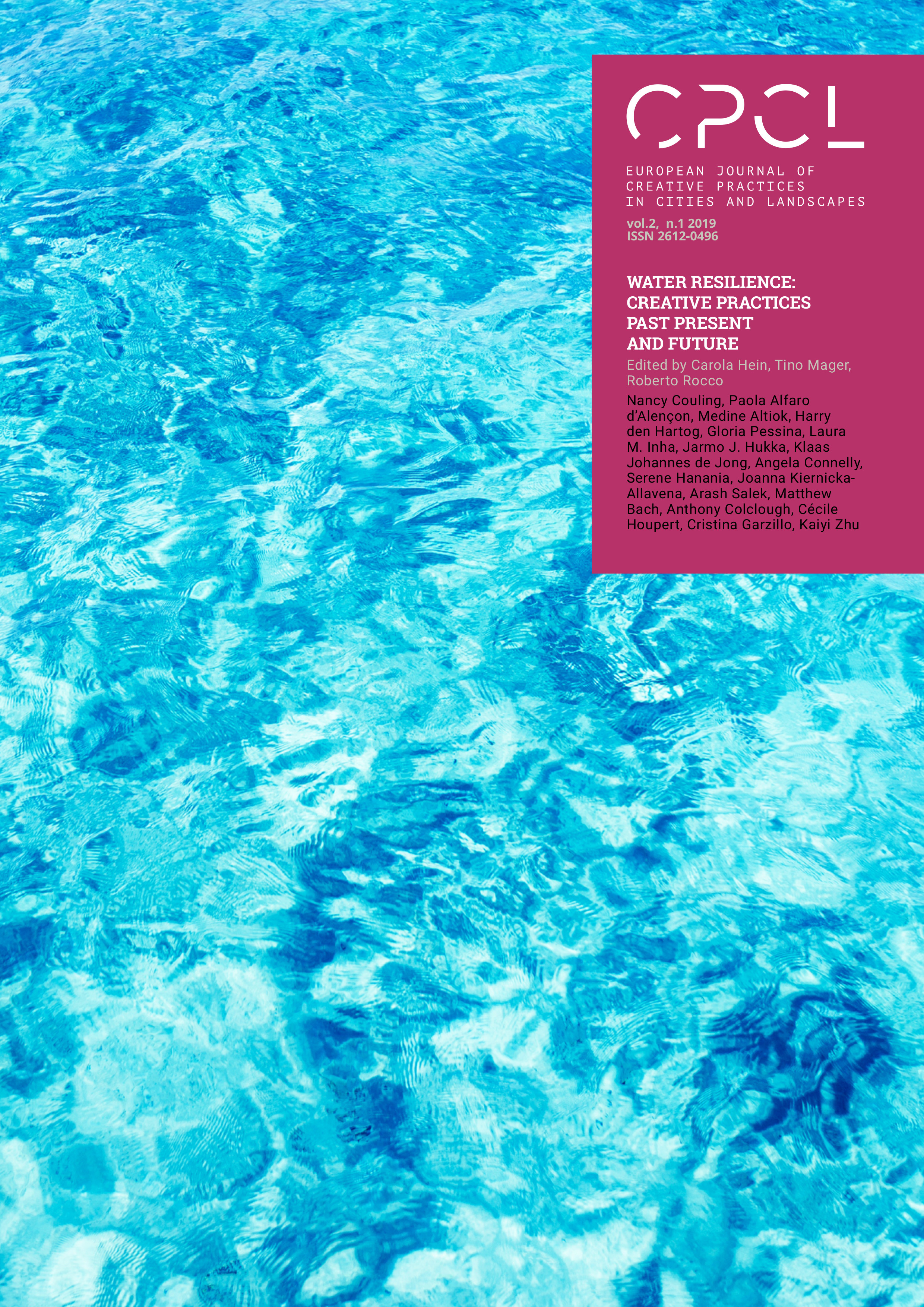Policies enabling resilience in Seattle's water services
DOI:
https://doi.org/10.6092/issn.2612-0496/8688Keywords:
water supply, wastewater, stormwater, water services management, water resilienceAbstract
The combined impact of diverse transitions, such as climate change, population growth, rapid urbanization and ageing infrastructure are expected to affect the quantity, quality, accessibility and affordability of water globally. Water demand and competition for water are likely to increase. Addressing these changes and hazards requires societies to be resilient, i.e. flexible and adaptive instead of only resistant. Seattle, Washington USA, has a long history of sustainable development and adaptation to changes and hazards such as population growth, water pollution, droughts and floods. Based on a literature review and semi-structured interviews among twelve selected local water professionals, this paper a) defines development steps and policies that have led to the current situation; b) explores key policies that are important to the resilience of Seattle’s water services; and c) examines challenges in and recommendations for improving resilience in the future. The results reveal the importance of specific policies and practices in enabling resilience for each water service: water supply, wastewater and stormwater. They also reveal governance levels where resilience is most powerfully implemented. The paper concludes that policies that were found to build and improve the resilience of Seattle’s water services are diverse and most effective when implemented at a local level. In advancing resilience, it is important to acknowledge also informal rules, including mindsets and habits.
References
Balk, Gene. “114,000 more people: Seattle now decade’s fastest-growing big city in all of U.S.” The Seattle Times, May 24, 2018. Accessed September 10, 2019 at https://www.seattletimes.com/seattle-news/data/114000-more-people-seattle-now-this-decades-fastest-growing-big-city-in-all-of-united-states/.
City Budget Office. “2019-2024 Proposed Capital Improvement Program”. Last updated September 24, 2018. Accessed September 10, 2019 at http://www.seattle.gov/financedepartment/1924proposedcip/default.htm.
Core Writing Team, Rajendra K. Pachauri and Leo Meyer, eds. Climate Change 2014: Synthesis Report. Contribution of Working Groups I, II and III to the Fifth Assessment Report of the Intergovernmental Panel on Climate Change. Geneva: IPCC, 2015. 151. Accessed September 10, 2019 at https://www.ipcc.ch/report/ar5/syr/.
Federal Emergency Management Agency (FEMA). “Earthquake Hazard Maps”. Last updated April 16, 2018. Accessed September 10, 2019 at https://www.fema.gov/earthquake-hazard-maps.
Folke, Carl. “Resilience (republished).” Ecology and Society 21 no. 4, 1–30 (2016). http://doi.org/doi:10.5751/ES-09088-210444.
Frostenson, Sarah. “America has a water crisis no one is talking about.” Vox, March 2018. Accessed September 10, 2019 at https://www.vox.com/science-and-health/2017/5/9/15183330/america-water-crisis-affordability-millions.
Heino, Ossi A., Annina J. Takala, and Tapio S. Katko, “Challenges to Finnish water and wastewater services in the next 20-30 years.” E-Water, EWA (2011). Accessed September 10, 2019 at http://www.ewa-online.eu/tl_files/_media/content/documents_pdf/Publications/E-WAter/documents/4_Challenges_A_TAKALA_OH_Final.pdf.
Johannessen, Åsa, and Christine Wamsler, “What does resilience mean for urban water services?” Ecology and Society 22, no. 1 (2017). https://doi.org/10.5751/ES-08870-220101.
Juuti, Petri, Tapio S. Katko, Kenneth Persson, and Riikka Rajala. “Shared history of water supply and sanitation in Finland and Sweden, 1860-2000.” Vatten. Föreningen Vatten. 65, no. 3 (2009): 165-175. Accessed September 10, 2019 at https://www.tidskriftenvatten.se/wp-content/uploads/2017/04/48_article_4013.pdf.
Karvonen, Andrew. “Metronatural™: Inventing and Reworking Urban Nature in Seattle.” Progress in Planning 74, no. 4 (November 2010): 153-202. https://doi.org/10.1016/j.progress.2010.07.001.
Katko, Tapio S., Petri S. Juuti, and Pekka E. Pietilä. “Key long-term decisions and principles in water services management in Finland, 1860-2003.” Boreal Environment Research 11, no. 5 (2006): 389-400. Accessed September 10, 2019 at http://www.borenv.net/BER/pdfs/ber11/ber11-389.pdf.
King County Wastewater Treatment Division. “King County’s regional wastewater conveyance and treatment system.” Last updated December 19, 2016. Accessed September 10, 2019 at https://www.kingcounty.gov/depts/dnrp/wtd/system.aspx.
Mantzavinos, C., Douglass C. North, and Syed Shariq. “Learning, Institutions, and Economic Performance.” Perspectives on Politics, Vol. 2, No. 1. (2004): 75-84. Accessed September 10, 2019 at https://doi.org/10.1017/S1537592704000635.
North, Douglass C. “Institutions.” The Journal of Economic Perspectives 5, no. 1 (Winter, 1991): 97-112. Accessed September 10, 2019 at https://doi.org/10.1257/jep.5.1.97.
Ofwat. Towards resilience: how we will embed resilience in our work. Birmingham, UK: Ofwat, 2015. Accessed September 10, 2019 at https://www.ofwat.gov.uk/wp-content/uploads/2015/07/pap_pos20151210towardsresiliencerev.pdf.
Ott, Jennifer. “City of Seattle adopts plan to build a combined sewer system, to handle sewage and stormwater, on November 30, 1891.” HistoryLink.org, January 16, 2015. Accessed September 10, 2019 at http://historylink.org/File/11013.
Rodina, Lucy. “Defining ‘water resilience’: Debates, concepts, approaches, and gaps.” WIREs Water 6, no. 2 (December 2018). https://doi.org/10.1002/wat2.1334.
Seattle Government, Office of Sustainability & Environment. “Adaptation: Preparing for Climate Change Impacts.” Accessed November 13, 2018 at https://www.seattle.gov/environment/climate-change/climate-planning/adaptation.
Seattle Government, Resilient Seattle. “Strategy.” Accessed November 13, 2018 at https://www.seattle.gov/resilience/strategy.
———. “What is Resilient Seattle?” Accessed November 13, 2018 at https://www.seattle.gov/resilience/what-is-resilient-seattle.
Seattle Public Utilities. SPU’s Risk and Resiliency Assessment and Framework, 2018 Status Report. Seattle Public Utilities, 2018, 17. Accessed September 10, 2019 at http://www.seattle.gov/util/cs/groups/public/@spu/@diroff/documents/webcontent/1_079774.pdf.
———. “Stormwater Management”. Accessed February 25, 2019 at http://www.seattle.gov/util/EnvironmentConservation/Projects/SewageOverflowPrevention/StormwaterManagement/index.htm.
———. “Strategic Business Plan, Update – 2018-2023”. Accessed November 13, 2018 at http://www.seattle.gov/util/AboutUs/StrategicBusinessPlan/index.htm.
———. “Volume 1 – 2019 Water System Plan,” Accessed February 25, 2019 at http://www.seattle.gov/util/cs/groups/public/@spu/@water/documents/webcontent/1_072557.pdf.
———. “Water System Overview: From mountain forests to faucet”. Accessed November 13, 2018 at https://www.seattle.gov/util/MyServices/Water/WaterSystemOverview/index.htm.
United Nations Office for Disaster Risk Reduction, UNISDR. “Terminology.” Accessed February 28, 2019 at https://www.unisdr.org/we/inform/terminology.
World Bank. “World Bank Disaster Risk Management Hub, Tokyo: Knowledge Program, Resilient Water Supply and Sanitation Services.” World Bank News, October 21, 2016. Accessed September 10, 2019 at http://www.worldbank.org/en/news/feature/2016/10/21/drmhubtokyo-knowledge-program-resilient-water-supply-and-sanitation-services.
World Economic Forum. The Global Risks Report 2018. Geneva: World Economic Forum, 2018, 69. Accessed September 10, 2019 at http://wef.ch/risks2018.
Published
How to Cite
Issue
Section
License
Copyright (c) 2019 Laura M Inha, Jarmo J Hukka
Copyrights and publishing rights of all the texts on this journal belong to the respective authors without restrictions.This journal is licensed under a Creative Commons Attribution 4.0 International License (full legal code).
See also our Open Access Policy.





